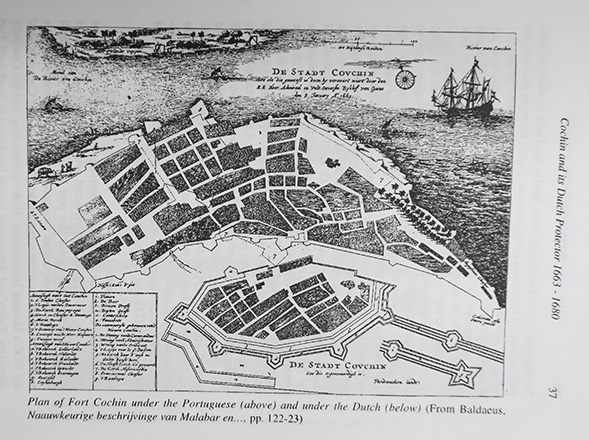In 1500 A.D., Unni Goda Varma Koil Thirumalpad of Elaya Thavazhi of Perumpadappu Swaroopam or Cochin Royal Family was the Raja of Cochin.
He was aware that his existence in vassalage to Samudiri ( Zamorin of Calicut) had to be redeemed if an opportunity arose. He had closely followed the Portuguese expedition to Calicut. He knew full well that the Moorish guns and boats had helped the Samudiri create havoc to Perumpadappu militia for a century. The Portuguese guns and boats were much superior and therefore befriending the Portuguese was the only option if such an opportunity presented itself before him.
During his first voyage,Vasco Da Gama did not come to Cochin. It was in December, 1500 A.D., that Pedro Alvarez Cabral from Portugal docked his boats at Cochin and the Raja of Cochin invited him for talks at his abode near Calvetty Bridge in Cochin.
“Cabral was, in every respect, much pleased with the King of Cochin, who, although much less wealthy than the Zamorin and consequently not living in so much state, was greatly superior to him in every other respect, being honest in his dealings and, intelligent and truthful in his conversation.”
– (C.P Achyutha Menon in " Cochin State Manual" ) and ( The Portuguese in India by Frederick Charles Danvers, vol 1, page 71).
A factory was given to the Portuguese, and their ships were laden with pepper and other articles in a span of two weeks.

Achyutha Menon; Cochin State Manual; page 71
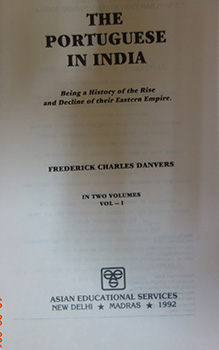
Quote on Cabral's impression of Raja of Cochin; page 71
The Raja also gave Cabral a letter of friendship, written on gold leaf, to be delivered to the King of Portugal. Cabral’s departure was abrupt and created displeasure for the King because he left with multiple Nayar hostages, including a young man who was closely related to the King’s consort. Cabral also did not make arrangements to provide security for the Portuguese left behind to manage the factory. These Portuguese, the King felt was his responsibility to protect at all costs. He provided safe haven for them in his own Palace
Another squadron of Portuguese vessels under Joao da Nova loaded pepper at Cannanore and proceeded to Cochin to load more spice. In Cochin, he was not allowed to trade for want of cash due to the machinations of the Moors. The Cochin King offered help and facilitated his trade.
Cabral received a warm welcome when he got back to Portugal. Based on his report, the King of Portugal decided to send to Malabar, a large force of twenty ships under the command of Da Gama again. He was well received by the Kolathiri King of Cannanore and a trade pact was negotiated. Da Gama then demanded that the Moorish traders be banned from Calicut, if Samudiri was to trade with the Portuguese. Samudiri declined. Da Gama exhibited his violent outburst by destroying the Arab fleet in a cold-blooded way. After unleashing all this fury and havoc, he proceeded to Cochin. In Cochin, he was cordial to the King and further strengthening of the ties between Portugal and Cochin was accomplished.
The departure of Da Gama signaled the escalation of hostilities between Samudiri and Cochin. Samudiri demanded the surrender of the Portuguese factory workers left behind in Cochin. There were some Cochin Princes and Chiefs who opted for what the Samudiri demanded, to avoid a war. However, the King, Unni Goda Varma, did not want to commit such a massive breach of faith.
The following excerpt of the letter from the Samudiri to the Cochin Raja, as seen in Sanjay Subramanian’s book ‘The Career and Legend of Vasco Da Gama’ is quite revealing:
Samorim: "to you Trimumpara [Thirumalpad], King of Cochin, I make it known to you that I have tried hard to avoid making war on you. Had you not wanted to be so contumacious and only did as I asked you, because it is just, and even of mutual profit, not to offer a place to the Christians, from whom we have received so much harm, and so this may go no further, in your wishing to continue in your ways, I have come here to Repelim [Eddapalli], determined to enter your land and to destroy it, and to seize the Christians with all their things. However, I pray to hand them over to me, and avoid seeing your own destruction and that of your land, which you may take as certain, and I shall divest myself of the hatred I have on you on account of the discourtesy of your letters, even though I have many complaints against you. And if you do not do this immediately, I promise the Gods that I will destroy you and depose you as King.
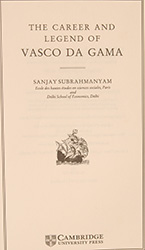
Subrahmanium's well-researched book
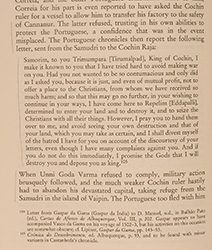
Declaration of war on Cochin by the Samorin
War brusquely followed, and weaker Cochin lost two Princes and several of its seasoned warriors. Eventually, the King had to abandon the devastated capital. He took refuge in the Elangunnapuzha Temple Sangetham ( The private territory inside a temple, under the strict governance of temple authorities) in Vaipin with the Portuguese.
The Cochin Raja had received the Portuguese with open arms and greeted them as friends. A new entente was formed and a new order of things was established, destined to survive many a storm for the next three hundred years. To them, he had promised every kind of help and support. For them, he fought valiantly, but in vain, against the cunning and the might of the Zamorin; and when at last, with his nephews killed and himself wounded, he sought refuge in the Elangunnapuzha Temple Sangetham, he took the Portuguese refugees along with him. “It is better to be driven out of one’s country”, replied the Raja to the refugees who were willing to be handed over to the Zamorin, “than not stand by one’s plighted word” – 'a notable example' writes Faria-Y-Souza, “of fidelity in a heathen, scarce to be paralleled among Christians”. The word 'Honour' was sacred to the Portuguese; 'Honour' was the “Family Treasure” of the Kings of Cochin.”
V.K.R. Menon writes in the booklet, 'COCHIN' - Edited by his brother, V.K.K Menon and published in 1941 : “ The Portuguese enterprise in the east was the 'last crusade' against the Moslem menace in the West. The deliverance of Jerusalem was their far-off ideal. Impulsive, sentimental and boastful and superstitious, the Portuguese were indeed the true sons of that inconsistent century, combining in their make-up the most callous cruelty with genuine kindness of heart."

The Portuguese enterprise in Cochin is characterized as the 'Last Crusade' by Menon.
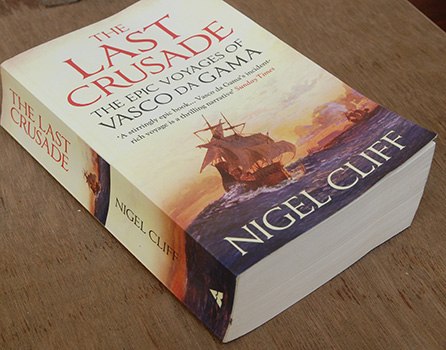
Nigel Cliff agrees with Menon's characterization of the 'last crusade.'
Francisco D’ Albuquerque arrived with a small fleet and rescued and returned the King and the followers who were in Vaipin, back to Cochin. Soon, they were joined by another ship under Duarte Pacheco to help the King of Cochin. Alfonso D’ Albuquerque also arrived to consolidate the Portuguese position and drive back the Zamorin to his own territory. At his request, a fort was constructed to protect the Portuguese factory. The Albuquerque’s returned in 1504, after cementing the relationships further between the two countries.
The Zamorin attacked again, but was beaten back time and again by the valiant and remarkable tactics of war employed by Duarte Pacheco. As far as Cochin was concerned, Pacheco was the greatest warrior from Portugal. The next fleet to arrive was that of Lopo Suarez and his contribution to the strengthening of Cochin was to defeat Cranganore, a staunch ally of the Zamorin . Pacheco returned to Portugal with Suarez and on the way did further damage to the remaining vessels of the Moors. Unni Goda Varma retired and became an ascetic as tradition dictated.
In 1505, Don Francisco D’Almeida took charge as the First Viceroy of Cochin. He was to crown the Raja of Cochin with a gold crown set with jewels. According to seniority and tradition, after Unni Goda Varma retired, Almeida crowned as the King, Unni Rama Koil of the Elaya Thavazhy, the direct nephew of the last Raja.
Almeida made his official residence in Cochin and Cochin became the seat of the Portuguese Government in India. In December, 1509, Alfonso D’ Albuquerque arrived in Cannanore with secret orders from the King of Portugal to replace Almeida who was overextending his stay and was unpopular with the King of Cochin because of his belligerent actions. After a tussle, Almeida was sent off, only to lose his life en route.
In 1510, Unni Goda Varma, the early friend of the Portuguese, who, by sheer courage and conviction saved the Cochin Kingdom, died. As per tradition Unni Rama Koil should have become a religious recluse and made room for the next Prince in succession. The Portuguese in Cochin objected to this. Unni Rama Koil was very reluctant to break the tradition. High-handedly, Albuquerque decreed that the succession to the throne will be confined to the Elaya Thavazhi only. For the next 150 years this practice was continued and alienated the other Thavazhis. However, he was unsuccessful in converting the Raja to Christianity. It was Albuquerque who convinced the King of Portugal to move the headquarters to Goa, the latter being a deep water port. He was very popular in Cochin, as well as in Goa, as an administrator. But, the Raja of Cochin was not happy on several counts and wrote several letters to the King of Portugal elaborating his displeasure. In 1515, the King of Portugal decreed his supercession and the Viceroy died, a broken man, in Goa.
Silvio A. Bedini published his book, “POPE’S ELEPHANT” in 1997. It was Albuquerque who chose the elephants and shipped them to Lisbon with input from the Raja of Cochin in 1511. A note indicated that one was a gift from the King of Cochin, and that the other was purchased for 101 crusades. The King of Cochin sent two naires (nayars) to accompany the animals. The Nayars were to be treated well and they were only to return after the elephants have been well trained. Furthermore, these elephants shall not carry any burden other than men. King Manuel presented the elephant to the Pope who cherished this gift. Bedini's book is based on his research in the Vatican records.
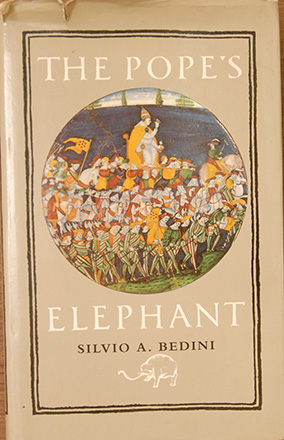
1513 A.D. An elephant in the Vatican.

A page from Bedini's book.
1537 - 1601
After Albuquerque, other Viceroys came and went, including the aging Vasco Da Gama who arrived in Goa in September 1524, and died two months later while at Cochin. In 1537, Unni Rama Varma Koil died after being the King of Cochin for 33 years. Cochin had attained a prominent position by this time and he was succeeded by an able King, Veera Kerala Varma who ruled until 1561. His relationship with Portugal was mixed. The Mattancheri Palace, now called theDutch Palace, was built then. The great plunder at Palluruthy Temple by the Portuguese also occurred at this time.
Raja Goda Varma ruled for just a span of 5 years. He was succeeded by Raja Ravi Varma. It was during his reign that the
‘Synod of Diamper’ took place at Udayamperur (near Tripunithura). The Synod or meeting or confluence was organized under the leadership of Alexio D' Menzes, the Archbishop of Goa to bring the native St.Thomas Christians into the Roman Church's fold. The Synod enacted fundamental changes in the rites and Ecclesiastical Laws of the St.Thomas Christians. The Synod issued 200 decrees in 9 sessions. It has been suggested that these decrees were first formulated in Portuguese and then translated to Malayalam. The participants were made to sign the Malayalam version. The final report of the Synod in Old Malayalam can be found in the National Archives of Lisbon( The Torres de Tombe).
Here are copies of two pages:
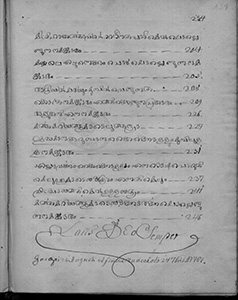
Decrees of the Synod of Diamper
He was followed by the extremely pious and able Raja Rama Varma. He had serious discussions with Arch Bishop Menezes about Christianity and the latter tried to convert the Raja but did not succeed. This Raja, according to Portuguese records, proceeded to Varanasi, where he died in 1601. In 1997, Jose Alberto Tavim published a short booklet about this Raja's visit to Varanasi titled ‘O rei que foi em peregrincao a Varanasi. Cartas de Rama Varma, raja de Cochim, nas Miscelaneas Manuscritas, de Nossa Senhora da Graca de Lisboa.'
By 1560, the power of the Raja had greatly increased. Within the next 30 years, the extensive territory known as Kurunad and Karappuram, lying between Alleppy and Palluruthy, passed into his private possession, this being brought about by diplomatic adoptions. Cochin quickly grew and flourished and became a fine city on the Malabar Coast
. Philip Baldaeus, in his book
The Coasts of Malabar and Coromandal, describes Cochin in glowing terms.
1605 -1656
Veera Kerala Varma was the King for 30 years, from 1605 to 1635. At this time, the sole heir to the Throne was Prince Goda Varma from the Muringur Thavazhy (branch) of the Royal Family. When he succeeded to the throne in 1635, Muringur merged with the Elaya Thavazhi because only members of the Elaya Thavazhy could become the King. In Goda Varma’s time, the Elaya Thavazhi was on the verge of extinction with only two males and an elderly female. At that time, the family adopted princes from all the collateral branches of Palluruthy, Mutha and Chazhiyur Thavazhys.
When Goda Varma died in 1645, a great scramble took place. The Portuguese insisted on making the Palluruthy Prince, the King and expelled the Princes from Mutha Thavazhi, as they never liked them to begin with. This King died in 1650 and was succeeded by Rama Varma of Chazhiyur, who reigned for 6 years.
Once again, when the Mutha Thavazhi Prince was the legitimate contender to the throne, the Portuguese, with support from Prince Ramana Koil of Travancore, persuaded the surviving female from Elaya Thavazhi to take over as Rani Gangadhara Laxmi.
A Vettath Raja had become a close ally of the Portuguese. After three years, Rani Gangadhara Laxmi was induced to adopt four Princes from Vettath. Rama Varma of Vettath was crowned in the Cathedral of Cochin. This brought the Mutha and the Chazhiyur branches together and they even sought help from the Zamorin!
A civil war was shaping up. Word came that The Dutch had captured the Portuguese Possessions in Ceylon. The Rajas of Malabar felt the power shift from one European country to another.
The close relationship that developed between the Great King of Cochin, Unni Goda Varma Koil Thirumalpad, his successor, Unni Rama Koil and the King of Portugal, Dom Manuel was to attenuate slowly. To paraphrase from the book, 'Cochin', V.K.R. Menon concludes: " After the days of Albuquerque, the relations between the Viceroys and the Cochin Rajas were never quite so intimate as before, more than one Viceroy was misled by the unostentatious life of the Raja and the smallness of his retinue, into the belief that he could be treated as a puppet and denied his legitimate share of the Port dues. But, they soon realized that his strength lay in his warriors spread over the land of his feudatories who were obliged to follow his lead in times of national danger. Moreover, an act of discourtesy towards his 'Friend and Ally' was always frowned upon by the King of Portugal. Lope Vad De Sampayo (Viceroy from 1526 to 1529 A.D.) was first to attempt such coercive measures. His successor, Nuno da Cunha found the Cochin Raja virtually a prisoner in his own Palace, "and like every other Prince in alliance with Portugal, a victim of injustice and oppression." Sampayo landed at Lisbon in irons, and for two years was confined in a dungeon in the castle. Portugal became part of Spain in 1577 A.D. and Don Francisco Mascarenhas, the first nominee of the Spanish Government committed the same error as Sampayo. He seized the Raja's custom house and refused to restore him the duties there levied. A serious rising of the people, however soon put matters right."
When the Portuguese first arrived, the fortunes of the Cochin Ruling Family were at a low ebb. Within a century, the Cochin Raja had become more powerful than the Zamorin. This was, in a large measure, due to Portuguese help and guidance.










